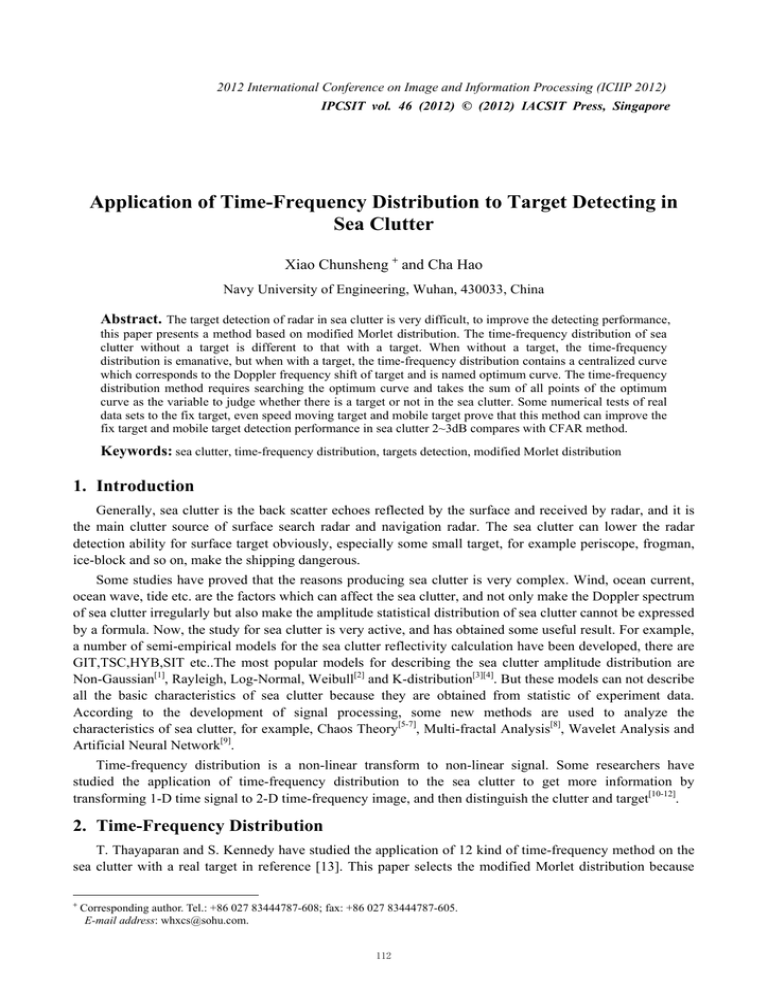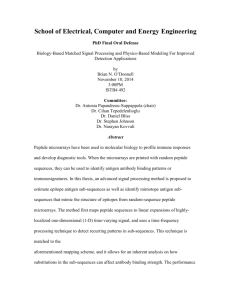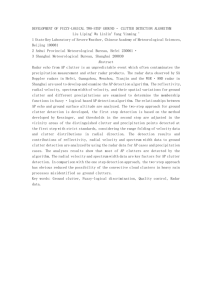Application of Time-Frequency Distribution to Target Detecting in Sea Clutter Xiao Chunsheng
advertisement

2012 International Conference on Image and Information Processing (ICIIP 2012) IPCSIT vol. 46 (2012) © (2012) IACSIT Press, Singapore Application of Time-Frequency Distribution to Target Detecting in Sea Clutter Xiao Chunsheng + and Cha Hao Navy University of Engineering, Wuhan, 430033, China Abstract. The target detection of radar in sea clutter is very difficult, to improve the detecting performance, this paper presents a method based on modified Morlet distribution. The time-frequency distribution of sea clutter without a target is different to that with a target. When without a target, the time-frequency distribution is emanative, but when with a target, the time-frequency distribution contains a centralized curve which corresponds to the Doppler frequency shift of target and is named optimum curve. The time-frequency distribution method requires searching the optimum curve and takes the sum of all points of the optimum curve as the variable to judge whether there is a target or not in the sea clutter. Some numerical tests of real data sets to the fix target, even speed moving target and mobile target prove that this method can improve the fix target and mobile target detection performance in sea clutter 2~3dB compares with CFAR method. Keywords: sea clutter, time-frequency distribution, targets detection, modified Morlet distribution 1. Introduction Generally, sea clutter is the back scatter echoes reflected by the surface and received by radar, and it is the main clutter source of surface search radar and navigation radar. The sea clutter can lower the radar detection ability for surface target obviously, especially some small target, for example periscope, frogman, ice-block and so on, make the shipping dangerous. Some studies have proved that the reasons producing sea clutter is very complex. Wind, ocean current, ocean wave, tide etc. are the factors which can affect the sea clutter, and not only make the Doppler spectrum of sea clutter irregularly but also make the amplitude statistical distribution of sea clutter cannot be expressed by a formula. Now, the study for sea clutter is very active, and has obtained some useful result. For example, a number of semi-empirical models for the sea clutter reflectivity calculation have been developed, there are GIT,TSC,HYB,SIT etc..The most popular models for describing the sea clutter amplitude distribution are Non-Gaussian[1], Rayleigh, Log-Normal, Weibull[2] and K-distribution[3][4]. But these models can not describe all the basic characteristics of sea clutter because they are obtained from statistic of experiment data. According to the development of signal processing, some new methods are used to analyze the characteristics of sea clutter, for example, Chaos Theory[5-7], Multi-fractal Analysis[8], Wavelet Analysis and Artificial Neural Network[9]. Time-frequency distribution is a non-linear transform to non-linear signal. Some researchers have studied the application of time-frequency distribution to the sea clutter to get more information by transforming 1-D time signal to 2-D time-frequency image, and then distinguish the clutter and target[10-12]. 2. Time-Frequency Distribution T. Thayaparan and S. Kennedy have studied the application of 12 kind of time-frequency method on the sea clutter with a real target in reference [13]. This paper selects the modified Morlet distribution because + Corresponding author. Tel.: +86 027 83444787-608; fax: +86 027 83444787-605. E-mail address: whxcs@sohu.com. 112 this distribution is very optimize in processing moving target and mobile target. The formula of modified Morlet distribution is SC x( r ) (t ′, a′; h) dtda = ∫∫ a′2 SCx (t , a; h)δ (t ′ − tˆ( x; t , a))δ (a′ − aˆ ( x; t , a )) 2 a there ⎧⎪ T (t , a; T )T * (t , a; h) ⎫⎪ h x tˆ( x; t , a ) = t − Re ⎨a x ⎬ 2 Tx (t , a; h) ⎩⎪ ⎭⎪ v0 vˆ( x; t , a) = aˆ( x; t , a) = ⎧⎪ T (t , a; D )T * (t , a; T ) ⎫⎪ v0 h x h + Im ⎨a x ⎬ 2 a 2π a Tx (t , a; h) ⎪⎩ ⎪⎭ and v0 is the initialization of vˆ( x; t , a) , Th (t ) = th(t ) , Dh (t ) = dh(t ) dt , h(t ) is Gauss window, SCx (t , a; h) is quantum figure, Tx (t , a; h) is Wavelet transform. 2 SC x (t , a; h) = Tx (t , a; h = 1 a * ∫ x( s )h ( s −t )ds a 2 3. Time-frequency Distribution Characteristic of Sea Clutter This part we will explain the difference of time-frequency distribution of sea clutter with a target and without a target by a example. The dataset are sampled from a coastal defense surveillance radar, The radar is located at Xiangshui Harbor Hainan China, and works at X-bond and plane polarization. Frequency Frequency Time/S Fig. 1: Time-frequency distribution of sea clutter Time/S Fig. 2: Time-frequency distribution of a mobile moving target Data set 1: no target Data set 2: a mobile moving target After doing time-frequency transform to data set 1 and data set 2, we get the time-frequency distribution image show as figure1 and figure 2 respectively. It is obvious that the time-frequency distribution of sea clutter is very unorderly, but that of a mobile moving target contains a clear focused strip. 4. Detector based on time-frequency distribution 4.1. Optimal curve From the past part we know that there is frequency trip in the time-frequency distribution chart of the sea clutter with a target. According to the calculation we can draw a conclusion that this frequency trip is same as the Doppler frequency shift. We define this frequency trip as optimal curve, and it is obvious that the optimal curve can be as the reason whether there is a target or not in the sea clutter. Defines S(m,n) as the time-frequency distribution of signal s(n), there m=1,2,……M is the abscissa of time, n=1,2,……N is the ordinate of frequency, and D is the max range of Doppler frequency shift. First, 113 selects a start point S(l,k) randomly, figure 3 is the example that S(3,4) is the start point and D equals 2 times frequency unit, then a. From the start point S(l,k), rightward and search out the max value point S (l +1 kj,) at time l+1 between S(l+1,k-D) and S(l+1,k+D), kj is the frequency ordinate and k-D≤kj≤k+D). In the example figure 3, S(4,3) is the max value point between S(4,2) and S(4,6). b. Take S (l+1, k j) as the new start point, rightward and search out the max value point at time l+2 between S(l+2,k j -D) and S(l+2,k j +D). c. Use the same method, search out the max value point at time l+3, l+4, ……, N. d. From the start point S(l,k), leftward and search out the max value point S (l -1 k i,) at time l-1 between S(l-1,k-D) and S(l-1,k+D), ki is the frequency ordinate and k-D≤ki≤k+D). In the example figure 3, S(2,6) is the max value point between S(2,2) and S(2,6). e. Take S (l-1, ki) as the new start point, leftward and search out the max value point at time l-2 between S(l-2,ki -D) and S(l-2,k i +D). f. Use the same method, search out the max value point at time l-3, l-4, ……, 1. g. Now we have search out N points with the start point S(l,k), the N points compose one curve. Because there are M×N points, we can search out M×N curves using the same steps. h. Sum all points’ value of every curve, and the optimal curve is the one has max sum value. i. Compare the max sum value with the limiting, if larger we consider it is a target, if smaller we consider it is clutter. Fig. 3: Method for searching the optimal curve 4.2. Detector based on time-frequency distribution Then we can describe the detector based on time-frequency distribution using figure 4. S(n) Time-frequency Select distribution Optimize Sum of curve Tmax Clutter Limiting intension Weight T0 Target adjusting >Target ≤Clutter Fig.4: Time-frequency distribution detector The signal of echoes is input into the detector. First transform the signal using time-frequency distribution, then search out the optimal curve and sum all points of the optimal curve. At the same time analysis the mean square and calculate the detecting limit. The function of weight is adjusting the limit manually. Compare the sum value with the limit, if the result is larger, the signal is a target, otherwise, the signal is clutter. 5. Applications 114 5.1. Optimal curve Use the sea clutter data set of part 3 and the mothod part 4 introduced, search out the optimal curve in time-frequency distribution plots of sea clutter with a target or withou a target. Figure 5 is the optimal curve without a target, figure 6 is the optimal curve with a mobile target. Frequency Frequency Time/S Time/S Fig. 5: Optimum curve of sea clutter without target Fig. 6: Optimum curve of sea clutter with a target 5.2. Detecting limit Use 500 samples of sea clutter, search out the optimal curve of every sample and calculate the sum value Tmax. Then there are 500 Tmax,s, rank them in order of size as show in figure 7. If the probability of false detecting equals 0.01(PFD=0.01), then the limit T0 should be set to the value larger than which there are 500×PFD in 500 Tmax,s, the value equals the mean of the 5th Tmax, and the 6th Tmax,. In figure 7, the horizontal line is the mean of the 5th Tmax, and the 6th Tmax,, which is the detecting limit and equals 2577. Tmax Sample Fig. 7 Tmax and threshold of samples 5.3. Target detecting The radar work in X band and plane polarization, the environment is moderate sea state. We have sampled 3 group data set, every group contains 500 sea clutter signal. Group 1 is sampled from a fixed target and sea clutter. Group 2 is sampled from a even-speed moving target and sea clutter. Group 3 is sampled from a mobile moving target and sea clutter. Set PFD=0.01, calculate Tmax of every sea clutter sample, and then do target detecting. First evaluate the detecting limit, then search out the optimal curve of time-frequency distribution and sum all points, last compare the sum value with the limit, if the result is larger, the signal is a target, otherwise, the signal is clutter. Fig.8: PND of fix target PND PND PND SCR(dB) SCR(dB) Fig.9: PND of target with fixed speed SCR(dB) Fig.10: PND of mobile target Figure 8, figure 9 and figure 10 show the detecting performance for fixed target, even-speed moving 115 target and mobile moving target respectively. These figure also show the detecting performance between CFAR method and time-frequency distribution method. The abscissa is signal clutter ratio(SCR), the ordinate is probability of no-detecting (PND). From figure 8, figure 9 and figure 10, we can draw some conclusion as follows. a. For the slow moving target or fixed target, the detecting performance of time-frequency distribution method is better than that of CFAR method in same SCR. But when the SCR is very small, the two methods cannot detect the target. b. For the even-speed moving target, the two methods have same detecting performance and when the SCR is very small, the two methods all cannot detect the target. c. For the mobile moving target, the detecting performance of time-frequency distribution method is better than that of CFAR method obviously, improves about 2-3dB. 6. Summarization This paper has analysised the time-frequency distribution characteristics of sea clutter using real radar data. According to the difference of characteristics between with a target and without a target, this paper presents a target detecting method based on time-frequency distribution and explains the main idea, design of detector, set of limit and parameters. The detecting performance of this method has been tested to the fixed target, even-speed moving target and mobile moving target, the result shows that the performance has improved obviously to the slow-moving target and mobile moving target in despite of that has not improved to the even-speed moving target. This target detecting method can be used to the real radar. 7. Reference [1] G. V. Trunk, S. F. George, Detection of Targets in Non-Gaussian Sea Clutter. IEEE Trans. On Aerospace and Electronic Systems, 1970,Aes-6(5). [2] D. C. Schleher, Radar Detection in Weibull Clutter. IEEE Trans. On Aerospace and Electronic Systems, 1976, Aes-12(6). [3] S. Sayama and M. Sekine, Weibull Distribution and K-Ditribution of Sea Clutter Observed by X-Band Radar and Analyzed by AIC. IEICE Trans. Commun., 2000, E83-B(9). [4] C. J. Baker, K-Distributed Coherent Sea Clutter. IEE Proceedings-F, 1991, 138(2). [5] Simon Haykin, Xiao Bo Li, Detection of Signals in Chaos[J]. Proceedings of the IEEE, 1995, 83(1):95-122. [6] MA Xiao-yan, HUANG Xiao-bin, ZHANG Xian-da, Modification of Chaotic Prediction-based Target Detection Method in Sea Clutter [J]. ACTA ELECTRONICA SINICA, 2003, 31(6):907-910. [7] DU Peng-fei, WANG Yong-liang, SUN Wen-feng, Weak Signal Detection in the Background of Chaotic Sea Clutter [J]. Systems Engineering and Electronics, 2002, 24(7):65-67. [8] Jing Hu, Wen-Wen Tung, Jianbo Gao, Detection of Low Observable Targets Within Sea Clutter by Structure Function Based Multi-fractal Analysis[J]. IEEE Transactions on Antennas and Propagation, 2006, 54(1):136-143. [9] Henry Leung, Neville Dubash, Nan Xie, Detection of Small Objects in Clutter Using a GA-RBF Neural Network[J]. IEEE Transactions on Aerospace and Electronic Systems, 2002, 38(1):97-118. [10] A.M. Sayeed and D.L. Jones, Optimal kernels for non-stationary spectral estimation[J], IEEE Trans. Signal Processing, 1995, 43:478-491. [11] CHEN Xinmin, ZHANG Mingbo. Small Target Detection in Sea Clutter Based on Time-frequency Distribution. Guidance & Fuze. 2008, 29(2):44-48. [12] ZHU Yupeng, WANG Hongqiang, XIAO Shunping. ISAR Imaging with Maneuvering Taget Based on Adaptive Kernel Time-frequency Distribution. Modern Rada. 2009, 31(3):38-42. [13] T. Thayaparan and S. Kennedy, Application of joint time-frequency representations to a maneuvering air targets in sea-clutter, DRDC Ottawa TM 2003-090. 116






